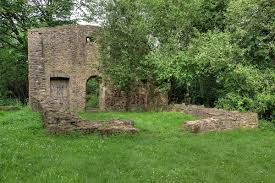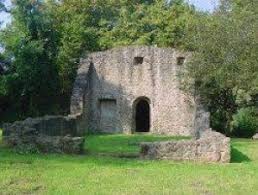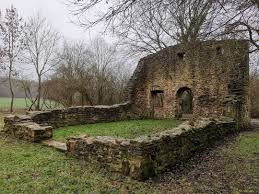Is the remnant of the restored 1992 church of Ashbach in Gersweiler.
The green area of the Church of Esbach - also known as Jöllenberg, Bistborg or Ziglów - is ideally situated just a short distance from today's buildings, wild fruit trees, the ruins of the former Church of Asbach, as a reminder of the village of 1692 Ashbach.
The ancient walls are one of the few remaining remnants of the Middle Ages and, moreover, of historical, architectural and artistic significance.
Date
As early as 900, the Aschbach farm was first mentioned, in 1200 it became the property of the Nassau-Saarbrucken Konte. Later it was already reported by the village of Abesbach, which stood in different manor sections, before passing through in 1312 by buying into the estate of St. Arnual Monastery.
At that time, the church of the medieval hall was already on the hill, and the palace - the so-called Freihof monastery - was next to it, and was nearby a brick building (already mentioned in 1252) and the villagers' cottages were probably on the other side of Aschbach, Foothill. For a long time, the court was the only church in the vicinity, where the inhabitants of the villages of Gerswiler and Otenhausen, who belonged to Mers (the director) of Absbach, were dependent on her church.
After the reform continued as the Church of the Protestants
After the reform (around 1575 in the Saarbrucken region), it continued as a Protestant church. Since the small church was still responsible for three places, they gave the entire area the name of their place "Aschbach". Only later, with the growing importance of Gersweiler, even after the establishment of the new local church, the name Gersweiler was changed. The Old Church became the property of the state.
In 1612, all the news of the village of Aschbach stopped. He is believed to have fallen victim to a fire. All that remains is the small church, which is now abandoned to decompose. The bell was seized in 1608 with the new church in Gerswiler.
"Church of Pests" and "Pestburg"
In the 30-year war, the country was plagued by plague, one of which identified the old church of Asbach, which is now alone, in Pestlasaret. For this purpose, the building was rebuilt in 1624, also with material from the Ashbach tiles at that time. Particularly violent riots broke out in 1626, 1628 and 1634. During this time, the hospital had to be expanded. Several years after the closure of Pestlazarett, this building was avoided, which bears the name "Pestkirche" or "Pestburg".
In 1666, the building was changed again. Count Gustav von Nassau Saarbrucken was built in a new square, which now became the name "Ziegelhof" - because of the bricks that had been working there for centuries. The former church was converted into a Manor house.
Bought 1739 Gersweiler Community Running Farm. After the auction in the revolutionary period in 1813, the farm passed as privately owned Aschbacherhof (several owner changes), the corresponding land was gradually sold. The Gersweiler-Ottenhausen Society in 1897 damaged the war years property 1870/71 again.
Historic and architectural value
At the end of the nineteenth century, people began to realize the historical and architectural value of the building. It was last used as a residence (until 1957). The last conversion was made in 1930 by the then resident, an architect.
Historical walls listed in 1932 were demolished in the list of monuments of the city and area in 1966 by the municipality with the permission of the district manager.
Already in 1962 investigations began on the ruins, and the last excavation was in 1990.




